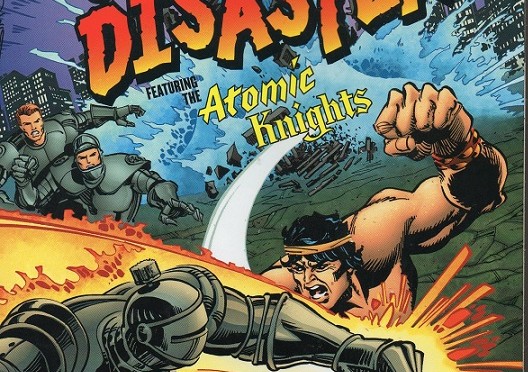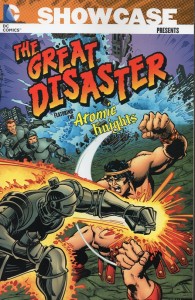Comic Book Review: Showcase Presents the Great Disaster Featuring the Atomic Knights by too many to list. Trust me, a lot of great names.
Between the late 1940s and somewhere in the 1990s, one of the most pervasive fears of the American public was atomic war. For the first time in known history, humans were truly capable of destroying all civilization, perhaps all life on Earth. One of the ways people dealt with this fear was science fiction. After all, the SF writers had forseen the possibility of annihilation well before such a thing was actually possible–and their stories would tell us the ways things might fall out. At DC Comics, this became a loose theme called “The Great Disaster.”
Unlike other Showcase volumes, this one collects not one series or character’s appearances, but a thematically linked set of stories, dealing with the aftermath of atomic war. As such, it provides a wide array of notable comics writers and artists.
The volume opens with a couple of stories about people traveling from after the Great Disaster to the present, or vice versa. This is followed by a collection of short-shock stories all titled “The Day After Doomsday”, presenting varied scenarios for what life after the Bomb might be like. Perhaps the most effective of these is the “Adam and Gertrude” trilogy.by Len Wein and Jack Sparling, but they all have their charms.
Then we have the feature event, the “Atomic Knights” stories. These were all by John Broome and Murphy Anderson. World War Three began in October 1986, and lasted less than a month, but wiped out much of human civilization, leaving a world without many animals or plants, and only a few pockets of humans struggling for survival. Into this world comes Sergeant Gardner Grayle. When he joined the Army, they discovered he was exactly average both mentally and physically, but during the War he was trapped in a bomb shelter that collapsed from a near-hit. The experience gave him traumatic amnesia, and only months after the disaster does he come to himself.
Grayle happens to be near a town named Durvale that was relatively untouched by the war, which is to say it’s a total wreck. It’s come under the thumb of the Black Baron (so named because of his hair color) who has managed to corner the local food supply. By coincidence, Grayle and a local school teacher, John Herald, discover that the suits of medieval armor in the museum have become resistant to most forms of radiation, including the ray-pistols used by the Black Baron and his men. There are six sets of armor, and soon Grayle and Herald recruit twin ex-soldiers Hollis and Wayne Hobbard, as well as scientist Bryndon (who is feared and despised for being one of those who made the bombs that ruined the world.) The last suit is deemed too small to be usable by any combat-ready man, so the Atomic Knight five set off. John’s sister, Marene Herald, who is small enough to fit in the last armor, takes it upon herself to follow them, and helps out in a tight situation.
The Atomic Knights became the new force for law and order in the post-apocalyptic world, fighting bizarre radiation-spawned monsters, evil dictators, the remnants of Atlantis and the mysterious mole people (who it turned out had actually caused the war.) Bit by bit, they began to make Earth liveable again.
These stories were all about the cool ideas, and were aimed primarily at children, so scientific plausibility and deep characterization were generally skipped. Bryndon being reluctant to discuss his pre-War research and the Hobard brothers being jazz fans was about as much as we learned about them as persons. Speaking of jazz, the early 1960s habit of only depicting white people in comics was on full display on a visit to New Orleans, where names of black performers are dropped, but there are no people of color in town. Marene, of course, is often excluded from dangerous missions and seems to have no particular skill set beyond “being feminine.” She even muses to herself that she’s “just a woman!” Perhaps appropriately, the last official Atomic Knights story from 1963 has her disguising herself as a boy and demonstrating some athletic talent.
Next up are stories of the return of the gods. There’s a one-shot about Atlas by Jack Kirby that doesn’t tie into anything in particular, but shared a resemblance to his Kamandi series, also set after the Great Disaster. The Kamandi series lasted long enough to get its own Showcase volume, so the next set of stories are Hercules Unbound, which ran 1975-77.
We open with Hercules bound to a rock, as he has been for the last millenium or so. Suddenly, the chains holding him snap–could this mean that Ares, who treacherously bound Hercules there, is dead? No time to think about that, as a blind boy and his dog are battling sea monsters nearby. Kevin, the blind boy, explains that he was in Greece when World War Three broke out, and he set out in a sailboat to see if he can get to his father, an ambassador to the Vatican. As it happens, Ares is in Rome, and very much alive, pitting the remnants of armies against each other for his own amusement. While Hercules triumphs against Ares’ champion, the opening chapter ends in tragedy for Kevin.
Hercules and his companions begin wandering the post-apocalyptic earth, encountering mad gods and mutants. There’s one person of color, a loincloth-clad hunter named Cerebus (not the aardvark) who is repeatedly referred to as “Nubian.” Yeah. The new-fangled “Women’s Lib” is mentioned a few times, mostly in association with Jennifer Monroe, a woman who was a model before the war, and mostly serves as a damsel in distress for Hercules.
Over the course of the series, it ties into OMAC, Kamandi and the Atomic Knights, despite these series not precisely being in continuity with each other. The last couple of chapters return to the question of why Hercules was chained to that rock in the first place; it answers some lingering subplots, ignores others, and flatly contradicts some of the earlier characterization. (The series had changed writers more than once in a dozen issues.)
After that are a few back-ups from Kamandi, and one last “The Day After Doomsday” shock story. To close out the volume, we have a Superman story from 1983. By this time, it was looking less and less likely that we would actually have an atomic war in 1986, and even if we did, it wouldn’t have the future-Fifties design aesthetic and cultural behavior seen in the Atomic Knights series. So when Superman suddenly finds himself in the Atomic Knights future, he is quick to point out the scientific implausibiliy of the scenario. Yes, this is hilarious coming from Mr. “The laws of physics are just mild suggestions.” Turns out it’s a virtual reality scenario gone horribly wrong, with the moral being “The task before man-kind isn’t to survive an atomic war! It’s to work in this world we’re living in to make certain such a war can never begin!” The story is also notable for giving Marene Herald a much more important role.
All together, this is a mixed bag with something for many comic book fans, including rare stories. It’s well worth a loan from your library, and if you’re a collector, consider buying it.



It’s really interesting how our culture dealt with the threat of atomic war through pop culture and comics. That seems to be happening now, but with different threats in mind.
A few years ago, I was eating sushi with some friends, when I suddenly became fed up with the zombie theme. “Why,” I said, attempting to lift a tuna roll, “are we suddenly inundated with so many zombie movies, zombie books, zombie everything?”
One of my friends, a very insightful man, said slowly, “I think it’s people’s way of dealing with the unknowns of environmental change and possible disaster. People are just coming to terms with the fear of the future, and right now those fears are about global warming, environmental toxins, and genetic mutation. So, we have zombies.”
Now that I’m typing this, I wonder: What’s up with all the vampire stories these days? What kind of issues is our culture facing via vampire fiction? Hmm.
Vampires traditionally represent a form of parasitism by the upper classes, note how the classic ones are usually nobility.They live off the sweat and blood of the working class, and even death doesn’t get rid of them.
But more recently, the “dark lover” part of the vampire has taken the fore. The man or woman who is dangerous but exciting to be with.